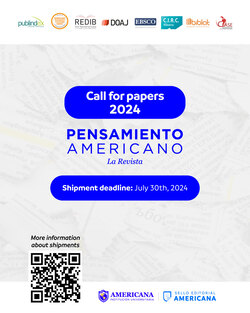Estructura procesual de la finitud en la lo?gica hegeliana
DOI:
https://doi.org/10.21803/pensam.v8i15.78Keywords:
Lógica Hegeliana; La finitud; Estructura procesual;Hegelian Logic; Finitude; Processual StructureAbstract
En la “Lo?gica del ser-ahi?”, Capi?tulo 2, Hegel habla de finitud, comenzando con un prea?mbulo en el cual profundiza en los momentos del camino de la lo?gica total. En una breve recapitulacio?n metodolo?gica, se reafirma que la primera parte del ser-ahi? (ser ahi?, en general, calidad y algo) tiene una estructura en la que la determinacio?n afirmativa es dominante; mientras que la segunda parte de la finitud (el algo y el otro, el ser-en-si? mismo, el ser-para-otro, la determinacio?n, la constitucio?n y el li?mite y el algo como finito) tiene una estructura negativa, es decir, la negacio?n de algo es en si? misma, introduciendo el tema de la alteridad desde la categori?a del otro. ¿Cua?l es la estructura lo?gica del algo como finito? El algo y el otro al momento del li?mite se muestran a si? mismos como finitos, ya que ambos se niegan entre si? como la negacio?n de la negacio?n. Entonces, el li?mite de algo y el otro se manifiesta a si? mismo como la negacio?n de la negacio?n, convirtie?ndose en contradictorio y precario. Hegel, al escribir su diale?ctica del algo y el otro, explica los objetos del mundo elaborando un nuevo concepto de sustrato a trave?s de la relacio?n entre los sustratos y la idea de procesualidad, la cual disuelve los sustratos y los provee de una nueva identidad, los sustratos en el movimiento de la relacio?n y la alteridad. Mientras que el pensamiento convencional representa el mundo como sustratos esta?ticos, el pensamiento diale?ctico revela la dimensio?n de procesualidad en el mundo con sentido.
Abstract
In the “Logic of Being-there”, Chapter 2, Hegel discusses Finitude, beginning with a preamble wherein he advances the moments of the whole logical path. In a brief methodological recapitulation, he reaffirms that the first part of being-there (being there in general, quality and something) has a structure in which affirmative determination is dominant; whereas the second part of finitude (something and other, being-in-itself, being-for-other, determination, constitution and limit and something as finite) has a negative structure, that is, the negation of something is within itself, introducing the theme of otherness from the category of the other. What is the logical structure of something as finite? Something and other at the moment of limit shows themselves as finite since they both negate each other as the negation of the negation. Then, the limit of something and other manifests itself as negation of negation, becoming contradictory and precarious. Hegel, in writing this dialectics of something and other, explains the objects in the world elaborating a new concept of a substrate through the relationship between substrates and the idea of processuality, which dissolves the substrates and provides them with a new identity, substrates in the movement of relationship and otherness. Whereas conventional thinking depicts the world as static substrates, dialectic thinking reveals the dimension of processuality in the world with meaning.
Resumo
No “Lo?gica do Ser-ai?”, capi?tulo 2, Hegel discute a finitude, comec?ando com um prea?mbulo em que ele avanc?a os momentos de todo o caminho lo?gico. Em uma breve recapitulac?a?o metodolo?gica, ele reafirma que a primeira parte do ser-ai? (estar la?, em geral, de qualidade e alguma coisa) tem uma estrutura em que a determinac?a?o afirmativa e? dominante; enquanto que a segunda parte da finitude (alguma coisa e outra, ser-em-si, ser-para-outro, determinac?a?o, constituic?a?o e limite e algo como finito) tem uma estrutura negativa, isto e?, a negac?a?o de alguma coisa reside em si mesmo, introduzindo o tema da alteridade a partir da categoria do outro. Qual e? a estrutura lo?gica de algo ta?o finito? Alguma coisa e outra coisa no momento do limite de mostra- rem-se como finitos, ja? que ambos negam um ao outro como a negac?a?o da negac?a?o. Em seguida, o limite de alguma coisa e outra coisa se manifesta como negac?a?o da negac?a?o, tornando-se contradito?rios e preca?rios. Hegel, ao escrever essa diale?tica de alguma coisa e outra coisa, explica os objetos no mundo elaborando um novo conceito de substrato atrave?s da relac?a?o entre os substratos e a ideia de processualidade, que dissolve os substratos e proporciona-lhes uma nova identidade, substratos em movimento de relacionamento e alteridade. Considerando que o pensamento convencional retrata o mundo como substratos esta?ticos, o pensamento diale?tico revela a dimensa?o da processualidade no mundo com significado/sentido.
Downloads
References
(1) Arndt, A. & Iber, C. (Orgs.) (2000). Hegels Seinslogik. Interpretationen und Perspektiven. Berlin: Akademie-Verlag.
(2) Iber, C. (2013). Manual para o Seminário Filosofia e Interdisciplinaridade: Introdução à Ciência da Lógica de Hegel. A lógica do seraí: o seraí, finitude e infinitude. Porto Alegre: PUCRS.
(3) Carlson, D. G. (2007). A Commentary to Hegel’s Science of Logic. New York: Palgrave Macmillan.
(4) Hegel, G. W. F. (1969). Wissenschaft der Logik I. Werkausgabe in 20 Bänden. Eva Moldenhauer, Karl Markus Michel, Vol. 5, Frankfurt am Main: Suhrkamp Verlag.
(5) Hegel, G. W. F. (1985). Enciclopédia das Ciências Filosóficas em Compêndio (1830). Translation: Paulo Meneses and José Machado. Vol. I. A ciência da lógica. São Paulo: Loyola.
(6) Hegel, G. W. F. (2013). B. A Finitude. Tradução: Christian Iber; Revisão Técnica: Luis Sander; Revisão Final: Karl Heinz Efke, Agemir Bavaresco e Tomás Farcic Menk. Revista Opinião Filosófica, 04(02), 340- 367. Porto Alegre.
(7) Taylor, C. (2014). Hegel. Trad. Nélio Schneider. São Paulo: É Realizações Editora.
(8) Theunissen, M. (1978). Sein und Schein. Die kritische Funktion der Hegelschen Logik [Ser e aparência. A função crítica da lógica hegeliana]. Frankfurt am Main: Suhrkamp.
Downloads
Published
Issue
Section
License
Copyright (c) 2015 Pensamiento Americano

This work is licensed under a Creative Commons Attribution-NonCommercial-NoDerivatives 4.0 International License.
The author or authors of an article accepted for publication in the Journal Pensamiento Americano will transfer all of the patrimonial rights to the American University Corporation free of charge, within which are included: the right to edit, publish, reproduce and distribute both print media as digital, in addition to include in article in international indexes and / or databases, likewise, the Editorial Seal is authorized to use the images, tables and / or any graphic material presented in the article for the design of covers or posters from the same magazine. By assuming the patrimonial rights of the article, it may not be partially or totally reproduced in any printed or digital media without its express permission.
AUTHORITY ASPECTS
For the Pensamiento Americano Journal, all the authors of an article have made substantial contributions to the research and the manuscript, and they share the responsibility when the article presents errors, fraud in some way or violations of copyright.
After submitting an article, the journal does not accept the addition, deletion or change in the order of the authors, in addition we reserve the right to release the article when it has been submitted to the journal and under no circumstances will American Thought accept the article. withdrawal of an article during any phase of the editorial process






